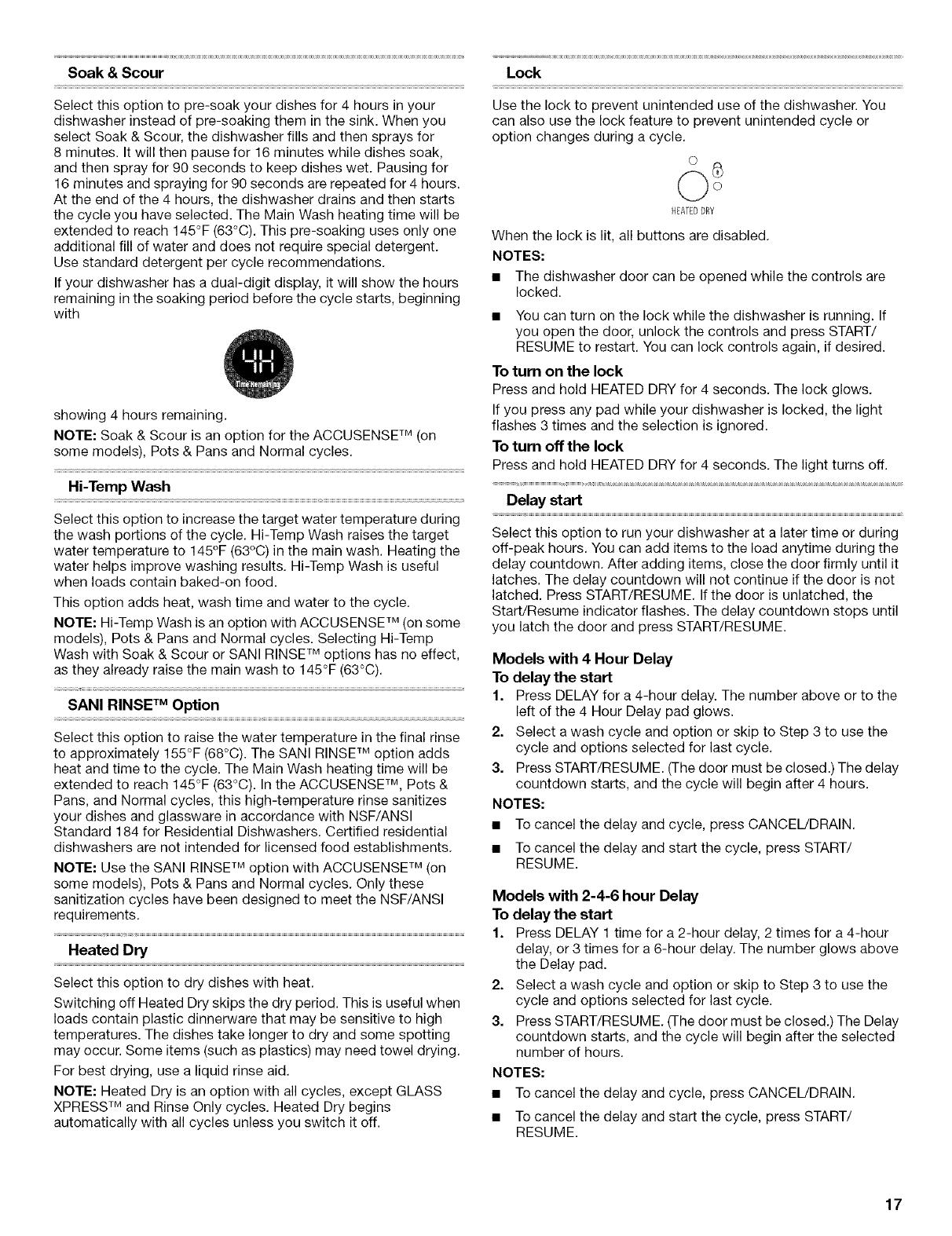
Soak & Scour Lock
Select this option to pre-soak your dishes for 4 hours in your
dishwasher instead of pre-soaking them in the sink. When you
select Soak & Scour, the dishwasher fills and then sprays for
8 minutes. It will then pause for 16 minutes while dishes soak,
and then spray for 90 seconds to keep dishes wet. Pausing for
16 minutes and spraying for 90 seconds are repeated for 4 hours.
At the end of the 4 hours, the dishwasher drains and then starts
the cycle you have selected. The Main Wash heating time will be
extended to reach 145°F (63°C). This pre-soaking uses only one
additional fill of water and does not require special detergent.
Use standard detergent per cycle recommendations.
If your dishwasher has a dual-digit display, it will show the hours
remaining in the soaking period before the cycle starts, beginning
with
showing 4 hours remaining.
NOTE: Soak & Scour is an option for the ACCUSENSE TM (on
some models), Pots & Pans and Normal cycles.
Hi-Temp Wash
Select this option to increase the target water temperature during
the wash portions of the cycle. Hi-Temp Wash raises the target
water temperature to 145°F (63°C) in the main wash. Heating the
water helps improve washing results. Hi-Temp Wash is useful
when loads contain baked-on food.
This option adds heat, wash time and water to the cycle.
NOTE: Hi-Temp Wash is an option with ACCUSENSE TM (on some
models), Pots & Pans and Normal cycles. Selecting Hi-Temp
Wash with Soak & Scour or SANI RINSE TM options has no effect,
as they already raise the main wash to 145°F (63°C).
SANI RINSE TM Option
Select this option to raise the water temperature in the final rinse
to approximately 155°F (68°C). The SANI RINSE TM option adds
heat and time to the cycle. The Main Wash heating time will be
extended to reach 145°F (63°C). In the ACCUSENSF M, Pots &
Pans, and Normal cycles, this high-temperature rinse sanitizes
your dishes and glassware in accordance with NSF/ANSI
Standard 184 for Residential Dishwashers. Certified residential
dishwashers are not intended for licensed food establishments.
NOTE: Use the SANI RINSETM option with ACCUSENSE TM (on
some models), Pots & Pans and Normal cycles. Only these
sanitization cycles have been designed to meet the NSF/ANSl
requirements.
Heated Dry
Select this option to dry dishes with heat.
Switching off Heated Dry skips the dry period. This is useful when
loads contain plastic dinnerware that may be sensitive to high
temperatures. The dishes take longer to dry and some spotting
may occur. Some items (such as plastics) may need towel drying.
For best drying, use a liquid rinse aid.
NOTE: Heated Dry is an option with all cycles, except GLASS
XPRESS TM and Rinse Only cycles. Heated Dry begins
automatically with all cycles unless you switch it off.
Use the lock to prevent unintended use of the dishwasher. You
can also use the lock feature to prevent unintended cycle or
option changes during a cycle.
_q_ATEDDRY
When the lock is lit, all buttons are disabled.
NOTES:
• The dishwasher door can be opened while the controls are
locked.
• You can turn on the lock while the dishwasher is running. If
you open the door, unlock the controls and press START/
RESUME to restart. You can lock controls again, if desired.
To turn on the lock
Press and hold HEATED DRY for 4 seconds. The lock glows.
If you press any pad while your dishwasher is locked, the light
flashes 3 times and the selection is ignored.
To turn off the lock
Press and hold HEATED DRY for 4 seconds. The light turns off.
Delay start
Select this option to run your dishwasher at a later time or during
off-peak hours. You can add items to the load anytime during the
delay countdown. After adding items, close the door firmly until it
latches. The delay countdown will not continue if the door is not
latched. Press START/RESUME. If the door is unlatched, the
Start/Resume indicator flashes. The delay countdown stops until
you latch the door and press START/RESUME.
Models with 4 Hour Delay
To delay the start
1. Press DELAY for a 4-hour delay. The number above or to the
left of the 4 Hour Delay pad glows.
2. Select a wash cycle and option or skip to Step 3 to use the
cycle and options selected for last cycle.
3. Press START/RESUME. (The door must be closed.) The delay
countdown starts, and the cycle will begin after 4 hours.
NOTES:
• To cancel the delay and cycle, press CANCEL/DRAIN.
• To cancel the delay and start the cycle, press START/
RESUME.
Models with 2-4-6 hour Delay
To delay the start
1. Press DELAY 1time for a 2-hour delay, 2 times for a 4-hour
delay, or 3 times for a 6-hour delay. The number glows above
the Delay pad.
2. Select a wash cycle and option or skip to Step 3 to use the
cycle and options selected for last cycle.
3. Press START/RESUME. (The door must be closed.) The Delay
countdown starts, and the cycle will begin after the selected
number of hours.
NOTES:
• To cancel the delay and cycle, press CANCEL!DRAIN.
• To cancel the delay and start the cycle, press START/
RESUME.
17



















